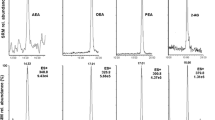Abstract
In head and neck cancer, tumor-infiltration into the bone is an important factor in the progress cancer and its treatment because of the proximity of the mucosa of this region to bones such as mandible and maxilla. Arachidonic acid metabolites in the bone tissue on cancerous infiltration have never been studied despite their importance in tumor growth and bone metabolism. Thirteen specimens of the tumor infiltrated bone and ten control specimens were therefore analyzed. Subjected to high performance liquid chromatography systems, some arachidonic acid metabolites were found to be increased after tumor infiltration.
Similar content being viewed by others
References
Luis, J, A., Angela, M,O. et al: The stimulation of the initiation of DNA synthesis and cell division in swiss mouse 3T3 cells by prostaglandin F2 α requires specific functional groups in the molecule. J. Biol. Chem. 258. 8774–8780, 1983.
Sevgi, B, R., Gideon, A, R. et al: Bone resorptive factor produced by osteosarcoma cells with osteoblastic feature is PG E2 Biochem. Biophys. Res. Commun. 102. 1358–1365, 1981.
Werner, E.J., Walenga, R.W. et al: Inhibition of human malignant neuroblastoma cell DNA synthesis by lipoxygenase metabolites of arachidonic acid. Cancer Res. 45. 561–563, 1985.
Ramstedt, U., Serhan, C.N. et al: Inhibition of human natural killer cell activity by (14R, 15S) 14, 15 dihydroxy 5Z, 8Z, 10Z, 10E, 12E icosateraenoic acid. Proc. Natl. Acad. Sci. U.S.A. 81. 6914–6918, 1984.
Kuehn, H., Poenicke, K. et al: Metabolism of [114C] arachidonic acid by cultured calf aortic endothelial cells: Evidence for the presence of a lipoxygenase pathway. PG LT Med. 17. 291–303, 1985.
Kiyoshi, Y., Junichi, T. et al.: A Study on Relations between Osteoinfiltration and arachidonic Acid Metabolites in Oral Cancer. J. Jpn. soc. 39. 567–573, 1990.
Oerung, L. and anmmerstroem, S.: Kinetics of the conversion of leukotriene C4 by γ glutamyl transpeptidase. Biochem. Biophys. Res. Commun. 106. 1304–1309, 1982.
Dahlen, S.E., Bjoerk, J. et al: Leukotrienes promote plasma leakage and leukocyte adhesion in postcapillary venules: In vivo effects with relevance to the acute inflammatory response Proc. Natl. Acad. Sci. U.S.A. 78. 3887–3891, 1981.
Camp, R.D.R., Couts, A.A. et al: Responses of human skin to intradermal injection of leukotriens C4, D4, and B4. Br. J. Pharmacol. 80. 497–502, 1983.
Soter, N.A., Lewis, R.A. et al: Local effect of synthetic leukotrienes (LTC4, LTD4, LTE4, and LTB4) in human skin. J. Invest. Dermatol. 80. 115–119, 1983.
Hamberg, M., Sevenson, J. et al: Thromboxanes: A new group of biologically active compounds derived from prostaglandin endoperoxydes Proc. Natl. Acad. Sci. U.S.A. 72. 2994–2998, 1975.
Moriyama, T., Takamura, H. et al: Elevation of cystosolic free Ca2+ is directly evoked by thromboxane A2 in human platelets during activation with collagen. J. Biochem. (Tokyo), 103. 901–902, 1988.
Honda, A., Morita, I. et al: Appearance of the arachidonic acid metabolic pathway in human promyelitic leukemia (HL 60) cells during monocytic differentiation. Biochem. Biophys. Acta. 877. 423–432, 1986.
Ohno, K., Fujiwara, M. et al: Metabolic dehydration product: Correlation with prostaglandin E2 induced growth inhibition. Biochem. Biophys. Res. Commun. 139. 808–815, 1986.
Cho, M.J. and Allen, M.A.: Chemical stability of prostacyclin (PG I2) in aquaous solution. Prostaglandins 15. 943–954, 1978.
Raisz, L.G., Vanderhoek, J.Y. et al: Prostaglandin synthesis by fetal rat bone in vitro: Evidence for a role of prostacyclin. Prostaglandins 17. 905–914, 1979.
Harris, M., Jenkins, M.V. et al: Prostaglandin production and bone resorption by dental cyst. Nature 245. 213–215, 1973.
Suzuki, M.: Treatment of jaw cyst with an irregational method (II). Int. J. Oral Surg. 14. 408–415, 1985.
Junichi, Tanaka.: Study on bone absorption and formation factor of jaw cyst. J. Jpn. Stomatol. Soc. 36. 658–667, 1987.
Tasijian, A.H. Jr., Voelkel, E.F. et al: Evidence that the bone resorption stimulating factor produced by mouse fibrosarcoma cell is prostaglandin E2. J. Exp. Med. 136. 1329–1343, 1972.
Voelkel, E.F., Tasijian, A.H. Jr. et al: Hypercalcemia and tumor prostaglandins: The VX2 carcinoma model in the rabbit. Metabolism 24. 973–986, 1975.
Author information
Authors and Affiliations
About this article
Cite this article
Yoshida, K., Tanaka, J. & Suzuki, M. Changes of arachidonic acid metabolites in the bone accompanying infiltration by head and neck tumors. J Bone Miner Metab 9, 10–14 (1991). https://doi.org/10.1007/BF02374900
Issue Date:
DOI: https://doi.org/10.1007/BF02374900




